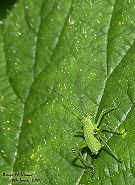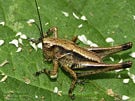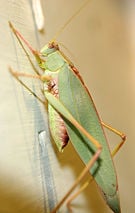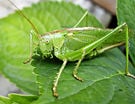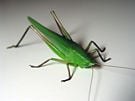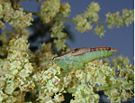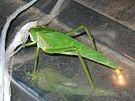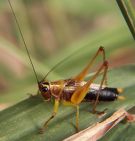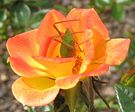Difference between revisions of "Tettigoniidae" - New World Encyclopedia
Rick Swarts (talk | contribs) |
Rick Swarts (talk | contribs) |
||
| Line 51: | Line 51: | ||
As member of the insect order [[Orthoptera]] (grasshoppers, crickets, katydids, and locusts), tettigoniids are characterized by chewing/biting mouthparts, [[metamorphosis|incomplete metamorphosis]] (hemimetabolism), and two pairs of wings, which are held overlapping the abdomen at rest. As with the other orthopterans, the the forewings are narrower than the hind wings and hardened at the base, while the hind wings are membranous and folded fan-like under the forewings when at rest. | As member of the insect order [[Orthoptera]] (grasshoppers, crickets, katydids, and locusts), tettigoniids are characterized by chewing/biting mouthparts, [[metamorphosis|incomplete metamorphosis]] (hemimetabolism), and two pairs of wings, which are held overlapping the abdomen at rest. As with the other orthopterans, the the forewings are narrower than the hind wings and hardened at the base, while the hind wings are membranous and folded fan-like under the forewings when at rest. | ||
| − | As members of the suborder Ensifera, which also includes [[cricket]]s, the tettigoniids are characterized by fine and threadlike antennae with well over 30 segments (except fossil representatives), stidulatory specializations of the forewings to make sounds, auditory organs (when present) linked via modified tracheae to the enlarged mesothoracic spiracles, | + | As members of the suborder Ensifera, which also includes [[cricket]]s, the tettigoniids are characterized by fine and threadlike antennae with well over 30 segments (except fossil representatives), stidulatory specializations of the forewings to make sounds, auditory organs (when present) linked via modified tracheae to the enlarged mesothoracic spiracles, a sword-like or needle-like six-valved ovipositor (when present), and elongate mandibles with a prominent incisor (Gwynne and Desutter 1996). |
Members of the family Tettigoniidae have tegmina (modified leathery front wings used in singing not flight) that can be held away from the body as "roof-like" structures, a left over right overlap of the male singing wings, four tarsal segments, a vestigial stridulatory file on the right wing, and a fully functional stridulatory file on the underside of the left wing (Gwynne and Morris 2002). Tettigoniids are distinguished from the [[grasshopper]]s (or short-horned grasshoppers) of the suborder Caelifera by the length of their [[antenna (biology)|antennae]], which is always relatively short in members of Caelifera. Tettigoniid antennae can reach to several times the body length. | Members of the family Tettigoniidae have tegmina (modified leathery front wings used in singing not flight) that can be held away from the body as "roof-like" structures, a left over right overlap of the male singing wings, four tarsal segments, a vestigial stridulatory file on the right wing, and a fully functional stridulatory file on the underside of the left wing (Gwynne and Morris 2002). Tettigoniids are distinguished from the [[grasshopper]]s (or short-horned grasshoppers) of the suborder Caelifera by the length of their [[antenna (biology)|antennae]], which is always relatively short in members of Caelifera. Tettigoniid antennae can reach to several times the body length. | ||
| Line 115: | Line 115: | ||
==References== | ==References== | ||
| − | Gwynne, | + | * Gwynne, D. T. and G. K. Morris. 2002. [http://tolweb.org/Tettigoniidae/13298/2002.11.26 Tettigoniidae. Katydids, Long-horned grasshoppers and bushcrickets]. ''Tree of Life Web Project'' Version 26 November 2002. Retrieved November 10, 2008. |
| − | Gwynne, | + | * Gwynne, D. T. and L. DeSutter. 1996. [http://tolweb.org/Ensifera/13315/1996.01.01 Ensifera. Crickets, katydids and weta]. ''Tree of Life Web Project'' Version 01 January 1996. Retrieved November 10, 2008. |
| − | Gwynne, | + | * Gwynne, D. T., L. DeSutter, P. Flook, and H. Rowell. 1996. [http://tolweb.org/Orthoptera/8250/1996.01.01 Orthoptera. Crickets, kaytdids, grasshoppers, etc.]. ''Tree of Life Web Project'' Version 01 January 1996. Retrieved November 10, 2008. |
| − | |||
| − | |||
| − | |||
| − | |||
==External links== | ==External links== | ||
| − | + | All links retrieved November 10, 2008. | |
| − | |||
*[http://www.cirrusimage.com/orthoptera_katydid.htm Bush katydid genus ''Scudderia'' Stål, 1873 - diagnostic photographs, natural history] | *[http://www.cirrusimage.com/orthoptera_katydid.htm Bush katydid genus ''Scudderia'' Stål, 1873 - diagnostic photographs, natural history] | ||
*[http://www.cirrusimage.com/orthoptera_katydid_Conocephalus.htm Black-sided meadow katydid - ''Conocephalus nigropleurum'' - diagnostic photographs] | *[http://www.cirrusimage.com/orthoptera_katydid_Conocephalus.htm Black-sided meadow katydid - ''Conocephalus nigropleurum'' - diagnostic photographs] | ||
* [http://bugguide.net/node/view/164 BugGuide.net—family ''Tettigoniidae ''] | * [http://bugguide.net/node/view/164 BugGuide.net—family ''Tettigoniidae ''] | ||
*[http://buzz.ifas.ufl.edu/index.htm Singing Insects of North America (SINA) website.] | *[http://buzz.ifas.ufl.edu/index.htm Singing Insects of North America (SINA) website.] | ||
| − | + | *[http://buzz.ifas.ufl.edu/katydids.htm North American katydids, with range maps and audio files of katydid songs.] | |
| − | *[http://buzz.ifas.ufl.edu/katydids.htm North American | ||
Revision as of 18:08, 10 November 2008
| Tettigoniidae
| ||||||||||||||
|---|---|---|---|---|---|---|---|---|---|---|---|---|---|---|
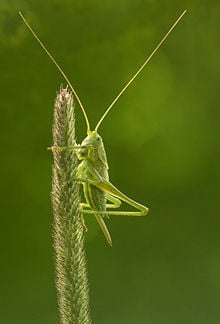 Great green bush-cricket
(Tettigonia viridissima) | ||||||||||||||
| Scientific classification | ||||||||||||||
| ||||||||||||||
|
Tettigoniidae is a major family of long-horned grasshoppers in the suborder Ensifera of the order Orthoptera, characterized by strong hind limbs for leaping, powerful mouth-parts for chewing, four tarsal segments, long and threadlike antennae (which have well over 30 segments and may exceed their own body length), stidulatory specializations of the forewings to make sounds, and a left over right overlap of the singing wings in males. Members of Tettigoniidae are known by the common name of katydids in the New World, Australia, and New Zealand, and bushcrickets in Europe, while the term long-horned grasshoppers is also used in some locations (sometimes in Australia and New Zealand as well), but sometimes also applies to members of Ensifera in general, a suborder that also includes the closely related crickets.
Tettigoniids are a very large group, with more than 6,400 species in over 1000 genera, and can be quite large (1 to 6 centimeters). They are found on all continents except Antarctica.
Some are also considered pests by commercial crop growers and are sprayed to limit growth. Large katydids can inflict a painful bite or pinch if handled but seldom break the skin.
Generally significant crop damage is rare because of low population densitites, but some are significant pests and some species aggregate in swarms, such as the flightless Mormon crickets.
positive impacts includes use as food and as singing pets in China.
Overview and description
As member of the insect order Orthoptera (grasshoppers, crickets, katydids, and locusts), tettigoniids are characterized by chewing/biting mouthparts, incomplete metamorphosis (hemimetabolism), and two pairs of wings, which are held overlapping the abdomen at rest. As with the other orthopterans, the the forewings are narrower than the hind wings and hardened at the base, while the hind wings are membranous and folded fan-like under the forewings when at rest.
As members of the suborder Ensifera, which also includes crickets, the tettigoniids are characterized by fine and threadlike antennae with well over 30 segments (except fossil representatives), stidulatory specializations of the forewings to make sounds, auditory organs (when present) linked via modified tracheae to the enlarged mesothoracic spiracles, a sword-like or needle-like six-valved ovipositor (when present), and elongate mandibles with a prominent incisor (Gwynne and Desutter 1996).
Members of the family Tettigoniidae have tegmina (modified leathery front wings used in singing not flight) that can be held away from the body as "roof-like" structures, a left over right overlap of the male singing wings, four tarsal segments, a vestigial stridulatory file on the right wing, and a fully functional stridulatory file on the underside of the left wing (Gwynne and Morris 2002). Tettigoniids are distinguished from the grasshoppers (or short-horned grasshoppers) of the suborder Caelifera by the length of their antennae, which is always relatively short in members of Caelifera. Tettigoniid antennae can reach to several times the body length.
The name "katydid" comes from the sound produced by species of the North American genus Pterophylla (literally "winged leaf"). The males of katydids have sound-producing organs (via stridulation) located on the hind angles of their front wings. Some species of Pterophylla produce a sound thought to resemble the words "Katy did, Katy didn't," hence the name. In some species of katydids, females are also capable of stridulation.
Distribution and habitat
Tettigoniids are found on all continents except Antarctica and in a wide assortment of habitats. These habitats range from tropical forests to high altitude zones in mountains above the treeline. These habitats are tied to vegetation, with katydids retreating into or onto leaves, unlike most other ensiferas that use burrows in soil or holes in wood. The wings of katydids may resemble leaves or sticks, providing camouflage (Gwynne and Morris 2002).
The spike headed katydid is somewhat notorious for its plantlike appearance, which allows it to blend in with the vegetation on which it lives, and the spikes discourage potential predators.
There are about 255 species in North America, but the majority of species live in the tropical regions of the world.
Behavior, diet, and reproduction
Katydids tend to be omnivorous, consuming leaves, flowers, bark, seeds, carrion, and at times prey. Some species, such as the Saginae, are exclusively predatory, feeding on other insects, snails or even small vertebrates such as snakes and lizards. Some katydids specialize on pollen, such as the Zaprochilinae (Gwynne and Morris 2002).
In virtually all katydids, the mating sequence begins with singing by the males. This involves raising of the wings and rubbing of a dorsal scrapper on the right tegmen across a file on the underside of the left tegmen (modified leathery front wing). Most females respond with silent phonotaxis (approaching the sound source) but some respond acoustically (Gwynne and Morris 2002).
During copulation, the males provide a nuptial gift for the females in the form of a spermatophylax as part of the spermatophore, a nutritious body produced with the males' ejaculate. The eggs are laid in plant tissue or soil.
The most common life cycle is the egg as an overwintering stage and a single generation per year, with a single period of cold required, but some species require up to five winters before the eggs hatch. Other species may have more than one generation per year. There typically are four to nine instars before reaching adulthood (Gwynne and Morris 2002).
Photo gallery
|
File:Katydid by night.jpg Katydid in the night near Torino, Italy | ||
ReferencesISBN links support NWE through referral fees
- Gwynne, D. T. and G. K. Morris. 2002. Tettigoniidae. Katydids, Long-horned grasshoppers and bushcrickets. Tree of Life Web Project Version 26 November 2002. Retrieved November 10, 2008.
- Gwynne, D. T. and L. DeSutter. 1996. Ensifera. Crickets, katydids and weta. Tree of Life Web Project Version 01 January 1996. Retrieved November 10, 2008.
- Gwynne, D. T., L. DeSutter, P. Flook, and H. Rowell. 1996. Orthoptera. Crickets, kaytdids, grasshoppers, etc.. Tree of Life Web Project Version 01 January 1996. Retrieved November 10, 2008.
External links
All links retrieved November 10, 2008.
- Bush katydid genus Scudderia Stål, 1873 - diagnostic photographs, natural history
- Black-sided meadow katydid - Conocephalus nigropleurum - diagnostic photographs
- BugGuide.net—family Tettigoniidae
- Singing Insects of North America (SINA) website.
- North American katydids, with range maps and audio files of katydid songs.
Credits
New World Encyclopedia writers and editors rewrote and completed the Wikipedia article in accordance with New World Encyclopedia standards. This article abides by terms of the Creative Commons CC-by-sa 3.0 License (CC-by-sa), which may be used and disseminated with proper attribution. Credit is due under the terms of this license that can reference both the New World Encyclopedia contributors and the selfless volunteer contributors of the Wikimedia Foundation. To cite this article click here for a list of acceptable citing formats.The history of earlier contributions by wikipedians is accessible to researchers here:
The history of this article since it was imported to New World Encyclopedia:
Note: Some restrictions may apply to use of individual images which are separately licensed.
